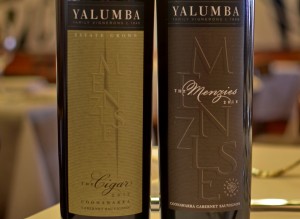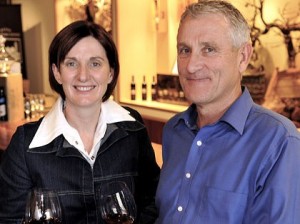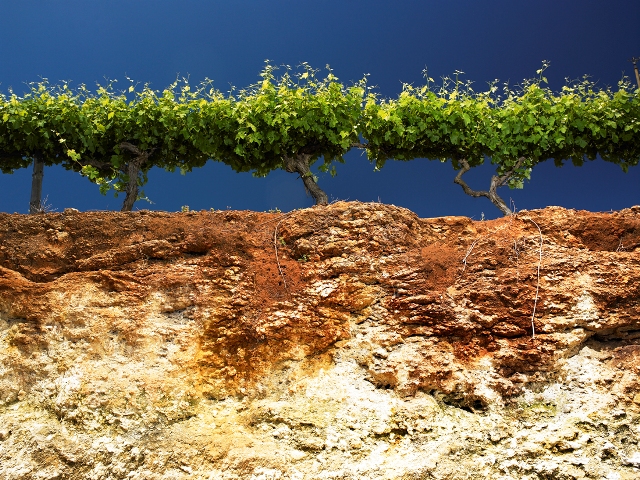‘To put it simply – we lost. We couldn’t afford the numbers of QCs that our opposition had … The boundary issue was imposed on us by the Geographical Indications Committee of the Australian Wine and Brandy Corporation. … [now we] have to live with some poorly framed legislation, with the greed of some big multinational wine companies and a questionable decision by the AAT and the Federal Court.’ Brian Lynn, Majella Wines
Decades ago, the late Bill Redman said: ‘From 1890 to 1945 you can write failure across the face of Coonawarra.’ Most of the wine was distilled into brandy, and in the 1930s the South Australian government offered ex-servicemen in the area a bounty of four pounds and ten pence an acre to remove their vines and convert the land to dairy farming. The vineyards of Coonawarra were soon reduced to 121 hectares from 365 hectares at the turn of the century.
In 1951, a far-sighted David Wynn decided to buy the stone winery and cellars built by John Riddoch back in the 1890s. At the time, the Redmans were the only people making wine in Coonawarra – a Shiraz they sold in bulk to Woodley Wines, and later to Thomas Hardy, Reynella, Leo Buring, Yalumba and Mildara. With red wine sales booming in the sixties, these companies soon rushed in to buy land and plant vineyards. A quarter of a century later, Coonawarra was building a reputation for producing Cabernets that rivalled the great reds of Bordeaux.
The Almighty Boundary Brawl
In the 1990s, Coonawarra was engulfed in a brawl that resembled those you see on the footy field. Here it was vignerons fighting to have their vineyards included in the official Coonawarra zone. That brawl continued through the 1990s and produced the worst possible result: the boundaries ended up drawn far and wide from the original cigar-shaped red soil strip the vignerons had long promoted as the secret of Coonawarra’s success.
‘A group of 44 Coonawarra grape growers and vignerons fought long and hard,’ says Brian Lynn, ‘to keep the boundaries of Coonawarra somewhere approximating the wonderful red strip. We were opposed by the Mildara Blass consortium, by Petaluma, by Rymill and by a number of disgruntled growers to the west.’ Yes, Petaluma!
The map makes pretty clear that the boundaries were drawn to make every vigneron in the area happy, never mind the protests from the wine writers who warned that the area’s reputation would suffer serious damage. This was akin to re-drawing the bounderies of Burgundy to range from Lyon to Paris. You can’t do stuff like that without impacting on the quality of the wine produced, and damaging the reputation of the area.
Coonawarra bulks up
That’s how high volume wines like Jamieson’s Run and Robertson’s Well suddenly cluttered retailers’ shelves, wines made from vineyards many miles from the terra rossa strip. Heavy discounts soon followed, and wine drinkers began to see Coonawarra as a source of cheap wine, but there was more to it than that: rezoning was merely the straw that broke the camel’s back.
‘When winemaker John Wade made the 1979 Wynns Coonawarra Estate Black Label Cabernet Sauvignon,’ Campbell Mattinson writes, ‘it was a 12,000 case blend. But not for long. Just before it was bottled, he was ordered to transform that blend into a 30,000 case blend, then forced to stretch that year’s Hermitage (shiraz) to similar limits. That simple anecdote tells a lot of what Wynns cabernet sauvignon is and pretty much always has been: a product of corporate design.’
The vast estate now has close to 1000 ha under vines, or 2500 acres by the old measure. That’s BIG. David Farmer says parent TWE owns about three quarters of Coonawarra’s vineyard area when you add up Wynns, Penfolds, Mildara, Lindemans, Rouge Homme and all. ‘Much of the fabled red strip is owned by Fosters [now TWE] who found when they joined the Southcorp vineyards with the Mildara vineyards they controlled by my estimate 70 – 80% of the core of the fabled red soil strip.’
Going for Bulk Wine
In the sixties and seventies, Coonawarra made fine ‘claret style reds’ that were often compared to the elegant reds of Bordeaux. There were mint and wintergreen characters, and lots of fine acidity, and Owen Redman said he could smell the pine trees in his reds. You would never confuse a Coonawarra Shiraz with one from the Barossa in those days, let alone one from the Hunter.
The late Dan Murphy wrote that the Redmans were juggling hard when to pick their grapes, always looking out for dark clouds on the horizon that brought the autumn rains. They often picked early, and that was fine for the Claret style reds the district was known for. I remember Redman’s ‘74s and ‘75s which were still made like that, but it all changed within a few years.
In the early 1980s, Lindemans made Coonawarra reds with ripe, jammy, stewed fruit overtones and, a few years later, Doug Bowen’s once fine reds hit 15% alcohol and more. Most makers in the area followed suit and began making big, ripe reds that were no longer easy to pick as Coonawarras.
During the eighties, mechanical pruning and harvesting had become the accepted norm. As James Halliday recalls: ‘… the major wineries were hellbent on producing the maximum yield per hectare at the lowest possible price. Pruning was mechanised and reduced to a minimum, and the grapes were mechanically harvested … low-cost viticulture had become a drug of addiction, facilitating discounting of already low-priced wines, yet providing a return on the annual running cost.’
The flat expanse of Coonawarra was the perfect terrain for automated bulk wine production, and Southcorp (and later Fosters and TWE) owned most of it. Of course there was a price to be paid: mechanical pruning and harvesting, and soil management that relied on chemicals, took their toll on the vines and the wines. By the time the boundaries of the once noble vignoble were stretched like rubber bands in 2003, Coonawarra’s fate was already well and truly sealed.
The Little Guys
 Yes, a few small makers remain. Sadly, most of them have followed the big, ripe red style, perhaps because the market has been conditioned to expect these from the area. Balnaves, Leconfield, Majella, Parker and Reschke are all making fine wines, if not elegant wines in the old style.
Yes, a few small makers remain. Sadly, most of them have followed the big, ripe red style, perhaps because the market has been conditioned to expect these from the area. Balnaves, Leconfield, Majella, Parker and Reschke are all making fine wines, if not elegant wines in the old style.
I admire Yalumba and Wynns for not following the herd here. Most Yalumba reds tend to weigh in at about 13.5% alcohol, and the two from the Menzies vineyard are no exception.
The 2012s are a touch bigger at 14%, reflecting the warm year. The Menzies 2012 is a great Coonawarra Cabernet, and the Cigar 2012 is not far behind and in our sweet spot for price. as I really admire Yalumba for charting a middle weight course with its reds, and these reds are in very capable hands – those of Peter Gambetta. The same goes for Wynns, where Sue Hodder has followed a similar course, keeping the reds in the 13.5 -14% band.
‘Coonawarra needs Wynns to be strong’
So says Justin Knock MW to the Drinks Business. The article reports on a masterclass held in London a few months ago, which concluded that ‘Coonawarra deserves greater international recognition for the quality of its Cabernets.’ Since most of the Cabernet down there is made by Wynns, and so much of the vineyard area is in Wynns’ care, it follows that Coonawarra needs Wynns to be strong.
Knock added that ‘the brand is already “getting stronger in Australia,” and recorded that the most cellared wines in the country are Penfold’s 389 and Wynns Black Label Cabernet.’ Knock’s colleague Anthony Rose praised Wynns winemaker Sue Hodder for her low-profile approach and quality focus. ‘Sue is one of the most unsung heroes of Australian wine,’ he said. ‘She has no ego at all, but she is also self-assured and confident in the direction she is going, but a bit overshadowed in Treasury Wine Estates [portfolio] by Penfolds.’
 No argument about the big part Sue Hodder has played in getting Wynns back on track. She and vineyard manager Allen Jenkins took on the herculean task of replanting large sections of vineyard that were no longer producing quality fruit, along with improving quality control in the winery. The black label Cabernets from 2006 onwards show that the effort was well worth it, and even the humble Shiraz has been in top form – the current 2013 is a cracker, and you can buy it for silly money: less than $12.
No argument about the big part Sue Hodder has played in getting Wynns back on track. She and vineyard manager Allen Jenkins took on the herculean task of replanting large sections of vineyard that were no longer producing quality fruit, along with improving quality control in the winery. The black label Cabernets from 2006 onwards show that the effort was well worth it, and even the humble Shiraz has been in top form – the current 2013 is a cracker, and you can buy it for silly money: less than $12.
Some of the other wineries followed Hodder’s and Jenkins’ example – more on that HERE. On the quality potential in Coonawarra,the db article quotes Brian Croser who once said: ‘The area with the most upside in Australia is Coonawarra, because it lost its way for so long.’ That nails it but this is a strange comment from a man who helped stretch Coonawarra’s boundaries.
TWE closes Wynns Coonawarra Winery
Just a few months ago, the company that owns more brands than it knows what to do with, decided to flog some of them and rationalize its winemaking operations. TWE’s Great Western and Wynns Coonawarra wine making will be transferred to its Karadoc facility in the Riverland. ‘Processing of masstige wine at Great Western and Wynns Coonawarra will be transferred to Wolf Blass,’ The Weekly Times tells us. In case you’re not familiar with the term ‘masstige’, marketers use it to describe mass-produced, relatively inexpensive goods with prestigious pretensions.
What will happen to Sue Hodder and her team down in Coonawarra? Who knows.
Cool Climate and Hot Air
Back with the masterclass event in London, the article homes in on the ‘site and climatic specifics of Coonawarra compared to other fine wine Cabernet-producing regions.’ Rose outlined the area’s advantages: the rich terra rossa for absorbing heat, the porous limestone bedrock for superb drainage, and the water table below for supplying water in dry seasons.
Rose used data compiled by Brian Croser to show that Coonawarra is a moderate and maritime region, with cold, wet winters and a long warm summer. Heat degree days is the accepted measure of the warmth of a vineyard region. You take the average temperature per day (°C) minus 10 multiplied by the number of days in the 7 month growing season (Oct to April in the Southern Hemisphere). The base is 10 because vines do not function below 10°C.
It’s hard to believe that Coonawarra sits in the middle of this list, but it does suggest that winemakers there should perhaps think more about their unique terroir and about returning to their cool climate roots. More on Terroir here
Kim





